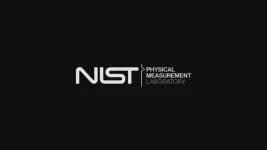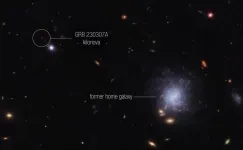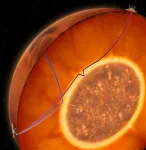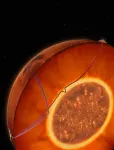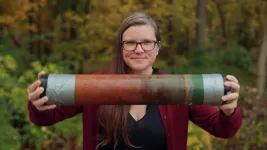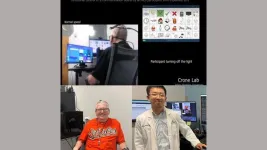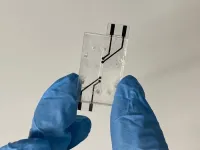(Press-News.org) Researchers at the National Institute of Standards and Technology (NIST) and their colleagues have built a superconducting camera containing 400,000 pixels — 400 times more than any other device of its type.
Superconducting cameras allow scientists to capture very weak light signals, whether from distant objects in space or parts of the human brain. Having more pixels could open up many new applications in science and biomedical research.
The NIST camera is made up of grids of ultrathin electrical wires, cooled to near absolute zero, in which current moves with no resistance until a wire is struck by a photon. In these superconducting-nanowire cameras, the energy imparted by even a single photon can be detected because it shuts down the superconductivity at a particular location (pixel) on the grid. Combining all the locations and intensities of all the photons makes up an image.
The first superconducting cameras capable of detecting single photons were developed more than 20 years ago. Since then, the devices have contained no more than a few thousand pixels — too limited for most applications.
Creating a superconducting camera with a greater number of pixels has posed a serious challenge because it would become all but impossible to connect every single chilled pixel among many thousands to its own readout wire. The challenge stems from the fact that each of the camera’s superconducting components must be cooled to ultralow temperatures to function properly, and individually connecting every pixel among millions to the cooling system would be virtually impossible.
NIST researchers Adam McCaughan and Bakhrom Oripov and their collaborators at NASA’s Jet Propulsion Laboratory in Pasadena, California, and the University of Colorado Boulder overcame that obstacle by combining the signals from many pixels onto just a few room-temperature readout wires.
A general property of any superconducting wire is that it allows current to flow freely up to a certain maximum “critical” current. To take advantage of that behavior, the researchers applied a current just below the maximum to the sensors. Under that condition, if even a single photon strikes a pixel, it destroys the superconductivity. The current is no longer able to flow without resistance through the nanowire and is instead shunted to a small resistive heating element connected to each pixel. The shunted current creates an electrical signal that can rapidly be detected.
Borrowing from existing technology, the NIST team constructed the camera to have intersecting arrays of superconducting nanowires that form multiple rows and columns, like those in a tic-tac-toe game. Each pixel — a tiny region centered on the point where individual vertical and horizontal nanowires cross — is uniquely defined by the row and column in which it lies.
That arrangement enabled the team to measure the signals coming from an entire row or column of pixels at a time rather than recording data from each individual pixel, drastically reducing the number of readout wires. To do so, the researchers placed a superconducting readout wire parallel to but not touching the rows of pixels, and another wire parallel but not touching the columns.
Consider just the superconducting readout wire parallel to the rows. When a photon strikes a pixel, the current shunted into the resistive heating element warms a small part of the readout wire, creating a tiny hotspot. The hotspot, in turn, generates two voltage pulses traveling in opposite directions along the readout wire, which are recorded by detectors at either end. The difference in time it takes for the pulses to arrive at the end detectors reveals the column in which the pixel resides. A second superconducting readout wire that lies parallel to the columns serves a similar function.
The detectors can discern differences in arrival time of signals as short as 50 trillionths of a second. They can also count up to 100,000 photons a second striking the grid.
Once the team adopted the new readout architecture, Oripov made rapid progress in increasing the number of pixels. Over a matter of weeks, the number jumped from 20,000 to 400,000 pixels. The readout technology can easily be scaled up for even larger cameras, said McCaughan, and a superconducting single-photon camera with tens or hundreds of millions of pixels could soon be available.
Over the next year, the team plans to improve the sensitivity of the prototype camera so that it can capture virtually every incoming photon. That will enable the camera to tackle such low-light endeavors as imaging faint galaxies or planets that lie beyond the solar system, measuring light in photon-based quantum computers, and contributing to biomedical studies that use near-infrared light to peer into human tissue.
The researchers reported their work in the Oct. 26 edition of Nature.
Researchers at the National Institute of Standards and Technology (NIST) and their colleagues have built a superconducting camera containing 400,000 pixels — 400 times more than any other device of its type.
Superconducting cameras allow scientists to capture very weak light signals, whether from distant objects in space or parts of the human brain. Having more pixels could open up many new applications in science and biomedical research.
The NIST camera is made up of grids of ultrathin electrical wires, cooled to near absolute zero, in which current moves with no resistance until a wire is struck by a photon. In these superconducting-nanowire cameras, the energy imparted by even a single photon can be detected because it shuts down the superconductivity at a particular location (pixel) on the grid. Combining all the locations and intensities of all the photons makes up an image.
The first superconducting cameras capable of detecting single photons were developed more than 20 years ago. Since then, the devices have contained no more than a few thousand pixels — too limited for most applications.
Creating a superconducting camera with a greater number of pixels has posed a serious challenge because it would become all but impossible to connect every single chilled pixel among many thousands to its own readout wire. The challenge stems from the fact that each of the camera’s superconducting components must be cooled to ultralow temperatures to function properly, and individually connecting every pixel among millions to the cooling system would be virtually impossible.
NIST researchers Adam McCaughan and Bakhrom Oripov and their collaborators at NASA’s Jet Propulsion Laboratory in Pasadena, California, and the University of Colorado Boulder overcame that obstacle by combining the signals from many pixels onto just a few room-temperature readout wires.
A general property of any superconducting wire is that it allows current to flow freely up to a certain maximum “critical” current. To take advantage of that behavior, the researchers applied a current just below the maximum to the sensors. Under that condition, if even a single photon strikes a pixel, it destroys the superconductivity. The current is no longer able to flow without resistance through the nanowire and is instead shunted to a small resistive heating element connected to each pixel. The shunted current creates an electrical signal that can rapidly be detected.
Borrowing from existing technology, the NIST team constructed the camera to have intersecting arrays of superconducting nanowires that form multiple rows and columns, like those in a tic-tac-toe game. Each pixel — a tiny region centered on the point where individual vertical and horizontal nanowires cross — is uniquely defined by the row and column in which it lies.
That arrangement enabled the team to measure the signals coming from an entire row or column of pixels at a time rather than recording data from each individual pixel, drastically reducing the number of readout wires. To do so, the researchers placed a superconducting readout wire parallel to but not touching the rows of pixels, and another wire parallel but not touching the columns.
Consider just the superconducting readout wire parallel to the rows. When a photon strikes a pixel, the current shunted into the resistive heating element warms a small part of the readout wire, creating a tiny hotspot. The hotspot, in turn, generates two voltage pulses traveling in opposite directions along the readout wire, which are recorded by detectors at either end. The difference in time it takes for the pulses to arrive at the end detectors reveals the column in which the pixel resides. A second superconducting readout wire that lies parallel to the columns serves a similar function.
The detectors can discern differences in arrival time of signals as short as 50 trillionths of a second. They can also count up to 100,000 photons a second striking the grid.
Once the team adopted the new readout architecture, Oripov made rapid progress in increasing the number of pixels. Over a matter of weeks, the number jumped from 20,000 to 400,000 pixels. The readout technology can easily be scaled up for even larger cameras, said McCaughan, and a superconducting single-photon camera with tens or hundreds of millions of pixels could soon be available.
Over the next year, the team plans to improve the sensitivity of the prototype camera so that it can capture virtually every incoming photon. That will enable the camera to tackle such low-light endeavors as imaging faint galaxies or planets that lie beyond the solar system, measuring light in photon-based quantum computers, and contributing to biomedical studies that use near-infrared light to peer into human tissue.
END
NIST team develops highest-resolution single-photon superconducting camera
Having more pixels could advance everything from biomedical imaging to astronomical observations
2023-10-25
ELSE PRESS RELEASES FROM THIS DATE:
Trauma, severe stress in childhood linked to criminal legal involvement in next generation
2023-10-25
A study led by UCLA researchers found that the children of parents who experienced adverse childhood experiences (ACEs)– such as abuse, neglect, violence in the home, or loss of a parent – are at increased risk of arrests and convictions by young adulthood. The authors report that their findings suggest that there is a crucial need for prevention of ACE exposure in the first place, as well as efforts to mitigate the impact of ACEs before they have downstream impacts on the next generation of children who are not yet born. The study appears in JAMA ...
Massive space explosion observed creating elements needed for life
2023-10-25
Scientists have observed the creation of rare chemical elements in the second-brightest gamma-ray burst ever seen – casting new light on how heavy elements are made.
Researchers examined the exceptionally bright gamma-ray burst GRB 230307A, which was caused by a neutron star merger. The explosion was observed using an array of ground and space-based telescopes, including NASA’s James Webb Space Telescope, Fermi Gamma-ray Space Telescope, and Neil Gehrels Swift Observatory.
Publishing their findings today in Nature (25 Oct), ...
InSight seismic data reveals a molten layer at the base of the Martian mantle
2023-10-25
The first data from the InSight mission made it possible to determine the internal structure of Mars in a series of papers from the scientific team published in the summer of 2021. However, since then, the analysis of new data generated by a powerful meteorite impact that occurred on September 18 2021, questioned the first estimates of the internal structure of the Red Planet. By studying the propagation times of waves generated by this impact, an international team led by Henri Samuel, CNRS researcher at the Institut ...
Scientists discover molten layer covering Martian core
2023-10-25
NASA’s InSight mission to Mars helped scientists map out Mars’ internal structure, including the size and composition of its core, and provided general hints about its tumultuous formation.
But findings from a new paper published in the journal Nature could lead to reanalysis of that data. An international team of researchers discovered the presence of a molten silicate layer overlying Mars’ metallic core—providing new insights into how Mars formed, evolved and became the barren planet it is today.
Published on October 25, 2023, the team’s paper details the use of seismic data to locate and identify a thin layer of molten ...
Sediment core analysis supports new epoch characterized by human impact on planet
2023-10-25
Scientists have long debated the Anthropocene Epoch, a proposed unit of geologic time corresponding to the most recent period in history. It’s characterized by substantial human impact on the planet.
Are we living in the Anthropocene? And if we are, then when did it start?
In a research article published this month in The Proceedings of the National Academy of Sciences, The University of Toledo’s Dr. Trisha Spanbauer and Stanford University’s Dr. M. Allison Stegner lend credence to the argument for its existence. The pair analyzed open-source data to track vegetation ...
Romance or nomance? Adolescents prefer to see less sex, more friendships, platonic relationships on screen
2023-10-25
Key takeaways
47.5% of respondents ages 13–24 feel most TV shows and movie plots don’t need sexual content; 51.5% want to see more focus on friendships and platonic relationships.
56% of those aged 10–24 prefer original content over franchises and remakes.
Twice as many adolescents prefer binge releases over weekly drops.
Adolescents want to see lives like their own depicted on screen.
This year’s Teens & Screens report from UCLA’s Center for Scholars & Storytellers, or CSS, found that teens — plus the 18- to 24-year-old demographic that advertisers typically ...
UK air pollution regulations will reduce deaths, but do little to protect ecosystems
2023-10-25
Existing air pollution regulations will reduce thousands of premature adult deaths in the UK, but even the most effective technically feasible actions, which will save thousands more lives, will do little to protect the country’s sensitive ecosystems, find UCL researchers.
The new research, published in GeoHealth, found that existing air pollution regulations could avoid 6,751 early deaths amongst adults in the UK by 2030 compared to if no regulations existed. That estimate nearly doubles to 13,269 avoided adult premature deaths if all possible technically feasible measures are employed to reduce air pollution immediately.
However, existing regulations don’t ...
Brain-computer interface restores control of home devices for Johns Hopkins patient with ALS
2023-10-25
It’s the day after the Baltimore Orioles clinched the American League East Championship with their 100th win of the season, and lifelong fan Tim Evans is showing his pride on his sleeve.
“It’s so great,” Evans, 62, says with a huge smile, wearing his orange O’s jersey.
The last time the Orioles won the AL East was in 2014, the same year Evans was diagnosed with amyotrophic lateral sclerosis (ALS), a progressive nervous system disease that causes muscle weakness and loss of motor and speech functions. Evans currently has severe speech and swallowing problems. He can talk slowly, but it’s hard for most people to understand him.
However, ...
Screen printed electrodes for measuring endothelial barrier integrity
2023-10-25
(LOS ANGELES) – October 25, 2023 - The Terasaki Institute for Biomedical Innovation (TIBI) has developed a novel organ-on-a-chip device for measuring electrical resistance across endothelial barriers. This chip had carbon-based, screen-printed electrodes incorporated into a multi-layered, microfluidic chip fabricated by a simple and cost-effective method.
Endothelial cells line blood and lymph vessels of the body and form a barrier layer which controls the flow of fluid and substances to and from the vessels and surrounding tissues. Study of the crucial roles ...
UTSA researchers receive $3.6 million National Science Foundation grant to break down language barriers in engineering education
2023-10-25
(SAN ANTONIO, OCTOBER 25, 2023)—The National Science Foundation (NSF) has awarded a five-year, $3.6 million grant to two professors at The University of Texas at San Antonio (UTSA) to develop a better way to communicate engineering acumen to diverse engineering classes.
Joel Alejandro Mejia and M. Sidury Christiansen are collaborating on an ethnographic project, “Rhetorical Engineering Education to Support Proactive Equity Teaching and Outcomes (RESPETO).” The project will include a handbook of recommended pedagogical approaches to address exclusionary language and linguistic practices in engineering classes.
The project was motivated by several factors. Among them, ...
LAST 30 PRESS RELEASES:
“Gifted word learner” dogs can pick up new words by overhearing their owners’ talk
More data, more sharing can help avoid misinterpreting “smoking gun” signals in topological physics
An illegal fentanyl supply shock may have contributed to a dramatic decline in deaths
Some dogs can learn new words by eavesdropping on their owners
Scientists trace facial gestures back to their source. before a smile appears, the brain has already decided
Is “Smoking Gun” evidence enough to prove scientific discovery?
Scientists find microbes enhance the benefits of trees by removing greenhouse gases
KAIST-Yonsei team identifies origin cells for malignant brain tumor common in young adults
Team discovers unexpected oscillation states in magnetic vortices
How the brain creates facial expressions
Researchers observe gas outflow driven by a jet from an active galactic nucleus
Pitt student finds familiar structure just 2 billion years after the Big Bang
Evidence of cross-regional marine plastic pollution in green sea turtles
Patients with clonal hematopoiesis have increased heart disease risk following cancer treatment
Stem cell therapy for stroke shows how cells find their way in the brain
Environment: Up to 4,700 tonnes of litter flows down the Rhine each year
Maternal vaccine receipt and infant hospital and emergency visits for influenza and pertussis
Interim safety of RSVpreF vaccination during pregnancy
Stem cell engineering breakthrough paves way for next-generation living drugs
California grants $7.4 million to advance gene-edited stem cell therapy for Friedreich’s ataxia
Victoria’s Secret grant backs cutting-edge ovarian cancer research
Research paves the way for safer colonoscopy bowel prep for people with compromised gut health
JMIR Publications and Sweden's National Library announce renewal and expansion of flat-fee unlimited open access partnership for 2026
A new 3D-printed solar cell that’s transparent and color-tunable
IV iron is the cost-effective treatment for women with iron deficiency anemia and heavy menstrual bleeding
Doing good pays off: Environmentally and socially responsible companies drive value and market efficiency
City of Hope and Cellares to automate manufacturing of solid tumor CAR T cell therapy
Short-circuiting pancreatic cancer
Groundbreaking mapping: how many ghost particles all the Milky Way’s stars send towards Earth
JBNU researchers propose hierarchical porous copper nanosheet-based triboelectric nanogenerators
[Press-News.org] NIST team develops highest-resolution single-photon superconducting cameraHaving more pixels could advance everything from biomedical imaging to astronomical observations
